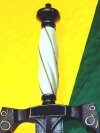-
The BladeForums.com 2024 Traditional Knife is ready to order! See this thread for details: https://www.bladeforums.com/threads/bladeforums-2024-traditional-knife.2003187/
Price is$300$250 ea (shipped within CONUS). If you live outside the US, I will contact you after your order for extra shipping charges.
Order here: https://www.bladeforums.com/help/2024-traditional/ - Order as many as you like, we have plenty.
You are using an out of date browser. It may not display this or other websites correctly.
You should upgrade or use an alternative browser.
You should upgrade or use an alternative browser.
fluting techniques
- Thread starter krangle1
- Start date
I have done quite a few flutes in wood. I have always used wood dowels as a sanding form, half round files and round files to start the flute (sometimes), and even cigarette butts as sanding forms. I have not yet fluted ivory, but that does sound good. Power tools can get away from you (ME) and I try to stay away from them when doing that type work.
Roger
Roger
- Joined
- Dec 7, 2000
- Messages
- 5,179
I'm with Roger, power tools and mammoth ivory seem a poor match.  I've used rattail or chainsaw files, sanding with leather-covered dowels. Never tried cig butts! Many people when doing this build a stand that allows the work to pivot around its axis; I haven't ever tried this but would recommend it! You might even chuck it up in your small lathe if you have one, just for holding the work. It's a thought anyway.
I've used rattail or chainsaw files, sanding with leather-covered dowels. Never tried cig butts! Many people when doing this build a stand that allows the work to pivot around its axis; I haven't ever tried this but would recommend it! You might even chuck it up in your small lathe if you have one, just for holding the work. It's a thought anyway.
Let us see your results! We revel in the great work of others.
Dave
Let us see your results! We revel in the great work of others.
Dave
- Joined
- Nov 4, 1998
- Messages
- 127
If you are doing straight flutes you can use a milling machine with a double angle cutter. When doing spiral flutes, first draw your lines and then cut your lines with a thin back saw so your lines do not disappear. After cutting the lines I use a small rasp to deeping the grooves and finish with sand paper.
Dave, I have made a rotating vise out of a bowling ball, dog food bowl and a drill press vise. Cut the boling ball in half set it in the dog food bowl and screw the vice on the bowling ball.
Dave, I have made a rotating vise out of a bowling ball, dog food bowl and a drill press vise. Cut the boling ball in half set it in the dog food bowl and screw the vice on the bowling ball.
- Joined
- Oct 6, 1998
- Messages
- 2,300
Here's a quick and easy way to lay out the flutes..
After you have turned the handle down to the diameter you want, mark a circle 1/16" in from the edge on each end. Mark 4 holes 90° apart, and parallel on each end of the handle. Drill a 1/16" hole 1/8" deep on all 8 marks. Put a piece of waxed thread in one of the holes and stick a toothpick in to hold it in place. Pull the string to the other end and move one hole over, put the thread in and hold it with a toothpick. This creates the twist. Mark along the thread with a pencil or scribe and do all 4 like this. You could move it 2 holes over for more of a twist or you can use any number of holes for more or less flutes.
After you have turned the handle down to the diameter you want, mark a circle 1/16" in from the edge on each end. Mark 4 holes 90° apart, and parallel on each end of the handle. Drill a 1/16" hole 1/8" deep on all 8 marks. Put a piece of waxed thread in one of the holes and stick a toothpick in to hold it in place. Pull the string to the other end and move one hole over, put the thread in and hold it with a toothpick. This creates the twist. Mark along the thread with a pencil or scribe and do all 4 like this. You could move it 2 holes over for more of a twist or you can use any number of holes for more or less flutes.
Attachments
- Joined
- Dec 7, 2000
- Messages
- 5,179
Ray, I like your rotating vise idea!
Dave
Dave
- Joined
- Sep 26, 1999
- Messages
- 4,486
Great idea Kit..Now let me throw a twist on this question,I am wanting to reproduce a antique hunting knife and it has a fluted handle only thing is the flutes look more like a rope spiraling all the way around the handle,How would you set that up?
Bruce
Bruce
- Joined
- Oct 6, 1998
- Messages
- 2,300
Bruce,
Pretty much the same way but use 8 holes on each end, 45° apart. The first 4 lines are narrow, shallow cuts and the ones in between are much wider. Lay a piece of rope beside the handle and you'll see what I mean.
Pretty much the same way but use 8 holes on each end, 45° apart. The first 4 lines are narrow, shallow cuts and the ones in between are much wider. Lay a piece of rope beside the handle and you'll see what I mean.
- Joined
- Sep 26, 1999
- Messages
- 4,486
Cool!!!!!!!
Thanks Kit..
Bruce
Thanks Kit..
Bruce

